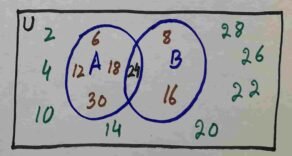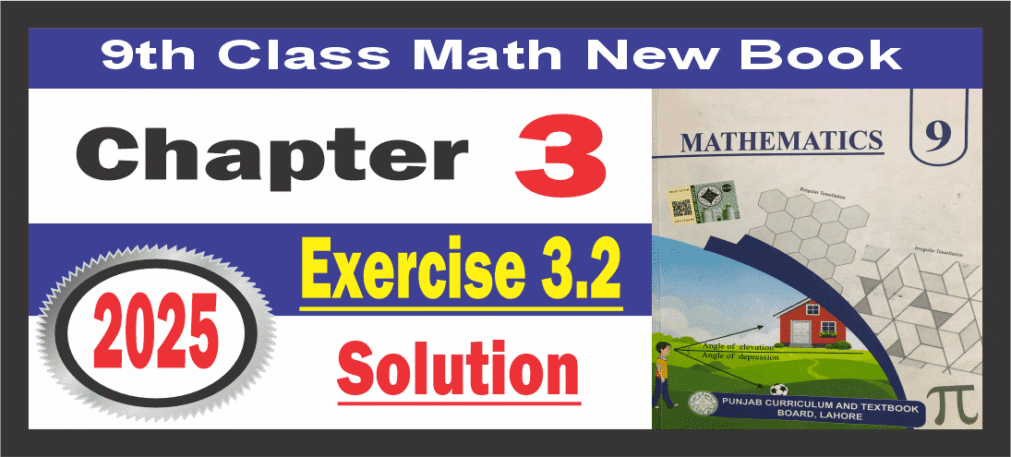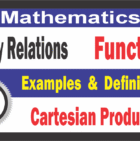Exercise 3.2 Math 9th | New Book Notes Punjab
Exercise 3.2 Math 9th New Book Notes Punjab board will be completely solved. New Book Notes Punjab Exercise 3.2 Math 9th.
Q1 Consider the universal set
$$U=\{x:x\;is\;multiple\;of\;2\;and\;0<x\leq30\}$$
A= { x:x is a multiple of 6 } and B= { x:x is a multiple of 8 }
(i) :-
List of all elements of sets A and B in tabular form
(ii) $$Find\;A\cap B$$
(iii)
Draw Venn diagram
Solution:-
i)
U = { 2, 4, 6, 8, 10, 11, 12, 14, 16, 18, 20, 22, 24, 26, 28 }
A = { 6, 12, 18, 24, 30 }
B = { 8, 16, 24 }
ii)
$$\;A\cap B\;=\;\{\;24\;\}$$
iii)

Q2 :- Let,
$$U=\{\;x:x\;is\;an\;integer\;and\;0<x\leq150\}$$
$$G=\{x:x\;=2^m\;for\;integer\;m\;and\;0\leq m\leq12\}\;\;$$
$$H=\{\;x:x\;is\;a\;square\;\}$$
(i) :-
List all element of sets G and H in tabular form
(ii) :-
Find GUH
(iii) :- $$Find\;G\cap H$$
Solution:-
i)
G= { 1,2,4,8,16,32,64,128}
H= {1,4,9,16,25,36,49,64,81,100,121,144}
ii)
GUH = {1,2,4,8,9,16,25,32,36,49,64,81,100,121,128,144}
iii)
$$G\cap H=\;\{1,4,16,64\}$$
Q3 Consider the sets
$$P=\{x:x\;is\;a\;prime\;number\;and\;0<x\leq20\}$$
$$Q=\{x:x\;is\;a\;divisor\;of\;210\;and\;0<x\leq20\}$$
(i):-
$$Find\;P\cap Q$$
(ii):-
Find PUQ
Solution:-
P={2,3,5,7,11,13,17,19}
Q={1,2,3,5,6,7,10,14,15}
i)
$$P\cap Q\;=\;\{2,3,5,7\}$$
ii)
$$P\cup Q\;=\;\{1,2,3,5,6,7,10,11,13,14,15,17,19\}$$
Q4 Verify the commutative properties of union and intersection for the following pairs of sets
(i):-
A={1,2,3,4,5}
B={4,6,8,10}
(ii):-
$$\mathbb{N}\;,\;\mathbb{Z}$$
(iii):-
$$A=\{x:x\in\mathbb{R}\wedge x\geq0\}\\B=\;\mathbb{R}\;$$
Solution:-
Commutative property of union
A U B = B U A
Commutative property on intersection
$$A\cap B\;=\;B\cap A$$
i):-
L.H.S = AUB = {1,2,3,4,5} U {4,6,8,10}
= { 1,2,3,4,5,6,8,10 }
R.H.S = BUA = {4,6,8,10} U {1,2,3,4,5}
= {1,2,3,4,5,6,8,10}
L.H.S = R.H.S
$$L.H.S\;=\;A\cap B\\\\=\{1,2,3,4,5\}\cap\{4,6,8,10\}\\=\{4\}$$
$$R.H.S\;=\;B\cap A\\\\=\{4,6,8,10\}\cap\{1,2,3,4,5\}\\=\{4\}$$
ii):-
A= N = {1,2,3,4,….}
B= Z = {0,1,2,3,….}
AUB = NUZ
= {1,2,3,….} U {0,1,2,3,…..}
={0,1,2,3,….} = Z
BUA = ZUN
= {0,1,2,3,….} U {1,2,3,….}
={0,1,2,3,….} = Z
Hence AUB = BUA
$$A\cap B=\;\mathbb{N}\;\cap\;\mathbb{Z}\\=\{1,2,3,…\}\cap\{0,1,2,3,…\}\\=\{1,2,3,….\}\;=\;\mathbb{N}$$
$$B\cap A=\;\mathbb{Z}\cap\mathbb{N}\\=\{0,1,2,3,…\}\cap\{1,2,3,…\}\\=\{1,2,3,….\}\;=\;\mathbb{N}$$
Hence
$$\;A\cap B=B\cap A$$
iii):-
$$A=\{x\vert x\in\mathbb{R}\wedge x\geq0\}\\B=\;\mathbb{R}$$
AUB = R
BUA = R
Hence AUB = BUA
$$A\cap B=\{x\vert x\in\mathbb{R}\wedge x\geq0\}=A\\B\cap A=\{x\vert x\in\mathbb{R}\wedge x\geq0\}=A$$
Hence
$$A\cap B\;=\;B\cap A$$
Q5 Let U={a,b,c,d,e,f,g,h,i,j} A={a,b,c,d,g,h} B={c,d,e,f,j} Verify De Morgan’s Laws for these sets. Draw Venn diagram
Solution:-
$$(\;A\cup B\;)’=A’\cap B’\\(\;A\cap B\;)’=A’\cup B’$$
Lets check $$(\;A\cup B\;)’=A’\cap B’$$
AUB = { a, b, c, d, g, h } U { c, d, e, f, j }
= { a, b, c, d, e, f, g, h, j, }
(AUB)’ = U – (AUB)
= { a, b, c, d, e, f, g, h, i, j } – {a, b, c, d, e, f, g, ,h, j }
= { i }
L. H. S = { i }
A’ = U – A
= { a, b, , c, d, e, f, g, h, i, j } – { a, b, c, d, g, h }
={ e, f, i, j }
B’ = U – B
= { a, b, c, d, e, f, g, h, i, j } – { c, d, e, f, j }
= { a, b, g, h, i }
$$\;A’\cap B’$$
= { e, f, i, j } – { a, b, g, h, i }
= { i }
R.H.S = { i }
Hence L.H.S = R.H.S
========================================
Lets Check $$(\;A\cap B\;)’=A’\cup B’$$
$$A\cap B=\{a,b,c,d,g,h\}\cap\{c.d.e.f.j\}\\=\{c,d\}$$
$$(A\cap B)’=U-(A\cap B)$$
= { a, b, c, d, e, f, g, h, i, j } – { c, d }
= { a, b, e, f, g, h, i, j }
L. H. S = { a, b, e, f, g, h, i, j }
A’ = U – A
= { a, b, c, d, e, f, g, h, i, j } – { a, b, c, d, g, h }
= { e, f, i, g }
B’ = U – B
= { a, b, c, d, e, f, g, h, i, j } – { c, d, e, f, j }
= { a, b, g, h, i }
A’ U B’
= { e, f, i, j } – { a, b, g, h, i }
= { a, b, e, f, g, h, i, j }
R.H.S = { a, b, e, f, g, h, i, j }
Hence L.H.S = R.H.S
========================================
Lets draw Venn diagrams
For Venn diagram check the following video
Q6 Let U = { 1,2,3,….,20 } A={1,3,5,….,19} Verify the following
$$(i)\;\;A\cup A’=\cup\;\;(ii)\;A\cap U=\;A\\(iii)\;A\cap A’\;=\;\{\;\}\;$$
Solution:-
A’ =U – A = {1,2,3,…,20} – {1,3,5,….,19} ={2,4,6,…,20}
(i)
L.H.S = AUA’ ={1,3,5,…,19} U {2,4,6,…,20}
={1,2,3,…,20}=U
=R.H.S
(ii)
$$L.H.S\;=\;A\cap U\\=\{1,3,5,…,19\}\cap\{\{1,2,3,…,20\}$$
={1,3,5,…,19}=A
=R.H.S
(iii)
$$L.H.S\;=\;A\cap A’\\=\{1,3,5,…,19\}\cap\{\{2,4,6,…,20\}$$
= { }
=R.H.S
Q7 In a class of 55 students, 34 like to play cricket and 30 like to play hockey. Also each student likes to play at least one of the two games. How many students like to play both games ?
Solution:-
|HUC| = 55 |H| = 30 |C| = 34
Principle of inclusion and exclusion for two sets
$$\vert H\cup C\vert=\vert H\vert\;+\;\vert C\vert\;-\vert H\cap C\vert$$
$$\vert H\cap C\vert=\vert H\vert\;+\;\vert C\vert\;-\vert H\cup C\vert\\\vert H\cap C\vert=30+34-55=9\\$$
Q8 In a group of 500 employees, 250 can speak Urdu , 150 can speak English, 50 can speak Punjabi, 40 can speak Urdu and English, 30 can speak both English and Punjabi, and 10 can speak Urdu and Punjabi. How many can speak all three languages ?
|U| = 250 |E| = 150 |P| 50
$$\vert U\cap E\vert=40,\;\vert E\cap P\vert=30,\;\vert U\cap P\vert=10\\\vert E\cup U\cup P\vert=500,\;\;\vert E\cap U\cap p\vert=?\\$$
Principle of Inclusion and exclusion for three sets
$$\vert E\cup U\cup P\vert=\vert U\vert+\vert E\vert+\vert P\vert\\-\vert U\cap E\vert-\vert E\cap P\vert-\vert U\cap P\\+\vert E\cap U\cap P\vert\\After\;putting\;the\;values\\\\500=250+150+50-40-30\\-10+\vert E\cap U\cap P\vert\\\\Hence\\\\130\;=\;\vert E\cap U\cap P\vert\\\\$$
Q9 In sport events, 19 people wear blue shirts, 15 wear green shirts, 3 wear blue and green shirts, 4 wear a cap and blue shirts, and 2 wear a cap and green shirts, The total number of people with either a blue or green shirt or cap is 25. How many people are wearing caps?
|B|= 19, |G|= 15, |C|= ?
$$\vert G\cap B\vert=3\\$$ $$\vert C\cap B\vert=4,\;\vert C\cap G\vert=2\\\vert B\cup G\cup C\vert\;=\;?\\\\$$
$$\vert B\cup G\cup C\vert\\=\vert B\vert+\vert G\vert+\vert C\vert-\vert B\cap G\vert\\-\vert C\cap B\vert-\vert C\cap G\vert+\vert B\cap G\cap C\vert\\\\$$
Principle of inclusion and exclusion
$$\vert B\cup G\cup C\vert=\vert B\vert+\vert G\vert+\vert C\vert\\-\vert B\cap G\vert-\vert C\cap B\vert-\vert C\cap G\vert+\vert B\cap G\cap C\vert\\\\$$
After putting the values, we get
25 = 19+ 15+ |C|- 3- 4- 2+ 0
25- 19- 15+ 3+ 4+ 2= |C|
|C| = 0
Q9 In sport events, 10 people wear blue shirts, 15 wear green shirts, 3 wear blue and green shirts, 4 wear a cap and blue shirts, and 2 wear a cap and green shirts, The total number of people with either a blue or green shirt or cap is 25. How many people are wearing caps?
|B|= 10, |G|= 15, |C|= ?
$$\vert G\cap B\vert=3\\$$ $$\vert C\cap B\vert=4,\;\vert C\cap G\vert=2\\\vert B\cup G\cup C\vert\;=\;?\\\\$$
$$\vert B\cup G\cup C\vert\\=\vert B\vert+\vert G\vert+\vert C\vert-\vert B\cap G\vert\\-\vert C\cap B\vert-\vert C\cap G\vert+\vert B\cap G\cap C\vert\\\\$$
Principle of inclusion and exclusion
$$\vert B\cup G\cup C\vert=\vert B\vert+\vert G\vert+\vert C\vert\\-\vert B\cap G\vert-\vert C\cap B\vert-\vert C\cap G\vert+\vert B\cap G\cap C\vert\\\\$$
After putting the values, we get
25 = 10+ 15+ |C|- 3- 4- 2+ 0
25- 10- 15+ 3+ 4+ 2= |C|
|C| = 9
Q9 In sport events, 19 people wear blue shirts, 15 wear green shirts, 3 wear blue and green shirts, 4 wear a cap and blue shirts, and 2 wear a cap and green shirts, The total number of people with either a blue or green shirt or cap is 34. How many people are wearing caps?
|B|= 19, |G|= 15, |C|= ?
$$\vert G\cap B\vert=3\\$$ $$\vert C\cap B\vert=4,\;\vert C\cap G\vert=2\\\vert B\cup G\cup C\vert\;=\;?\\\\$$
$$\vert B\cup G\cup C\vert\\=\vert B\vert+\vert G\vert+\vert C\vert-\vert B\cap G\vert\\-\vert C\cap B\vert-\vert C\cap G\vert+\vert B\cap G\cap C\vert\\\\$$
Principle of inclusion and exclusion
$$\vert B\cup G\cup C\vert=\vert B\vert+\vert G\vert+\vert C\vert\\-\vert B\cap G\vert-\vert C\cap B\vert-\vert C\cap G\vert+\vert B\cap G\cap C\vert\\\\$$
After putting the values, we get
34 = 10+ 15+ |C|- 3- 4- 2+ 0
34- 10- 15+ 3+ 4+ 2= |C|
|C| = 9
Q10 In a training session, 17 participants have laptops, 11 have tablets, 9 have laptops and tablets, 6 have laptops and books, and 4 have both tablets and books. eight participants have all three items. The total number of participants with laptops, tablets, or books is 35. How many participant have books?
|L|= 17, |T|= 11, |B|= ?
$$\vert L\cap T\vert=9,\;\vert L\cap B\vert=6\;\vert T\cap B\vert=4\;\\\vert L\cap T\cap B\vert=8\\\\$$
| L U T U B | = 35
Principle of inclusion and exclusion
$$\vert LUTUB\vert=\vert L\vert+\vert T\vert+\vert B\vert\\-\vert L\cap T\vert-\vert L\cap B\vert-\vert T\cap B\vert+\vert L\cap T\cap B\vert\\\\$$
35 = 17+ 11+ |B|- 9- 9- 4+ 8
35 = 36- 19+ |B|
|B| = 18
Q11 A shopping mall has 150 employees labelled 1 to 150, representing the Universal set U. The employees fall into the following categories;
- Set A: 40 employees with a salary range of 30K-45K, labelled from 50 to 89.
- Set B: 50 employees with a salary range of 50K-80K, labelled from 101 to 150.
- Set C: 60 employees with a salary range of 100K-150K, labelled from 1 to 49 and 90 to 100.
$$(a)\;Find\;(\;A’UB’)\;\cap C\;\\\;(a)\;Find\;n\{\;A\cap(B’\cap C’\;)\;\}\;\\\\$$
Solution:-
A’ = All labels except 50 to 89
= { 1, 2, 3, . . . . 49, 90, 91, . . . . 150 }
B’ = All labels except 101 to 150 }
= {1, 2, 3, . . . . 100 }
(a):-
A’UB’ = { 1, 2, 3, . . . . 49, 90, 91, . . . . 150 } U {1, 2, 3, . . . . 100 }
= { 1,2,3,4,…..150 }
$$(A’\cup B’)\cap C\\=\{1,2,3,…,150\}\cap\{1,2,3,…,49,90,91,…,100\}\\=\{1,2,3,…..,150\}\\\\$$
(b):-
B’ = {1,2,3…,100} C’ = {50,51,52,…,89,101,101,…,150}
$$B’\cap C’\\=\{1,2,3,…,100\}\cap\{50,51,52,…,89,101,…,150\}\\=\{\;50,51,52,……..,89\;\}\\\\$$
$$A\cap(B’\cap C’)\\=\{50,51,52,…,89\}\cap\{50,51,52,…,89\}\\=\{50,51,52,…,89\}\;=\;A\\\\$$
$$Hence\\n\{A\cap(B’\cap C’)\}\;=\;40\\\\$$
Q12 In a school with 1 25 students participants in at least one of the following sports: cricket, football, or hockey.
- 60 students play cricket.
- 70 students play football.
- 40 students play hockey.
- 25 students play both cricket and football.
- 15 students play both football and hockey.
- 10 students play both cricket and hockey.
(a) How many students play all three sports?
(b) Draw a Venn diagram showing the distribution of sports participation in all games.
Solution:-
(a):-
| C | = 60, | F |= 70, | H | = 40
$$\vert C\cap F\vert=25,\;\vert F\cap H\vert=15,\;\vert C\cap H\vert=10\\\\\vert C\cup F\cup H\vert\;=\;125,\;\vert C\cap F\cap H\vert\;=\;?$$
Principle of Inclusion and Exclusion for three sets
$$\vert C\cup F\cup H\vert=\vert C\vert+\vert F\vert+\vert H\vert-\vert C\cap F\vert\\-\vert F\cap H\vert-\vert C\cap H\vert+\vert C\cap F\cap H\vert$$
After putting the value , we get
$$125=60+70+40-25\\-15-10\;+\;\vert C\cap F\cap H\vert$$
$$\vert C\cap F\cap H\vert\;=\;5$$
(b):- For Venn Diagram click on the following link
Q13 A survey was conducted in which 130 people were asked about their favourite foods. The survey results showed the following information:
- 40 people said they liked nihari.
- 65 people said they liked biryani.
- 50 people said they liked korma.
- 20 people said they liked nihari and biryani.
- 35 people said they liked biryani and korma.
- 27 people said they liked nihari and korma.
- 12 people said they liked all three foods nihari, biryani, and korma.
(a) At least how many people like nihari, biryani or korma?
(b) How many people did not like nihari, biryani or korma?
(c) How many people like only one of the following foods: nihari, biryani, or korma?
(d) Draw a Venn diagram.
Solution:-
(a):-
|N| = 40, |B| = 65, |K| = 50, |NUBUK| = ?
$$\vert N\cap B\vert=20,\;\;\vert B\cap K\vert=35,\;\\\\\vert N\cap K\vert=27,\;\;\vert N\cap B\cap K\vert=12$$
Principle of inclusion and exclusion
$$\vert N\cup B\cup K\vert=\vert N\vert+\vert B\vert+\vert K\vert\\-\vert N\cap B\vert-\vert N\cap K\vert-\vert B\cap K\vert\\+\vert N\cap B\cap K\vert$$
After putting the values we get
$$\vert N\cup B\cup K\vert=40+65+50\\-20-27-35+12$$
$$\vert N\cup B\cup K\vert\;=\;85$$
(b):-
People who didn’t like Nihari, Biryani or Korma = 130-85 = 45
(c):-
People who like only Nihari
$$=\vert N\vert-\vert N\cap B\vert-\vert N\cap K\vert+\vert N\cap B\cap K\vert$$
= 40 – 20 – 27 + 12 = 5
People who like only Biryani
$$=\vert B\vert-\vert K\cap B\vert-\vert N\cap B\vert+\vert N\cap B\cap K\vert$$
= 65 – 35 – 20 + 12 = 22
People who like only Korma
$$=\vert K\vert-\vert K\cap B\vert-\vert N\cap K\vert+\vert N\cap B\cap K\vert$$
= 50 – 35 – 27 + 12 = 0
People who like only one of the food = 5 + 22 + 0 = 27
(d):-
For Venn Diagram click on the following link
Other than Exercise 3.2 Math 9th New Book Notes Punjab Check! Some important links below




